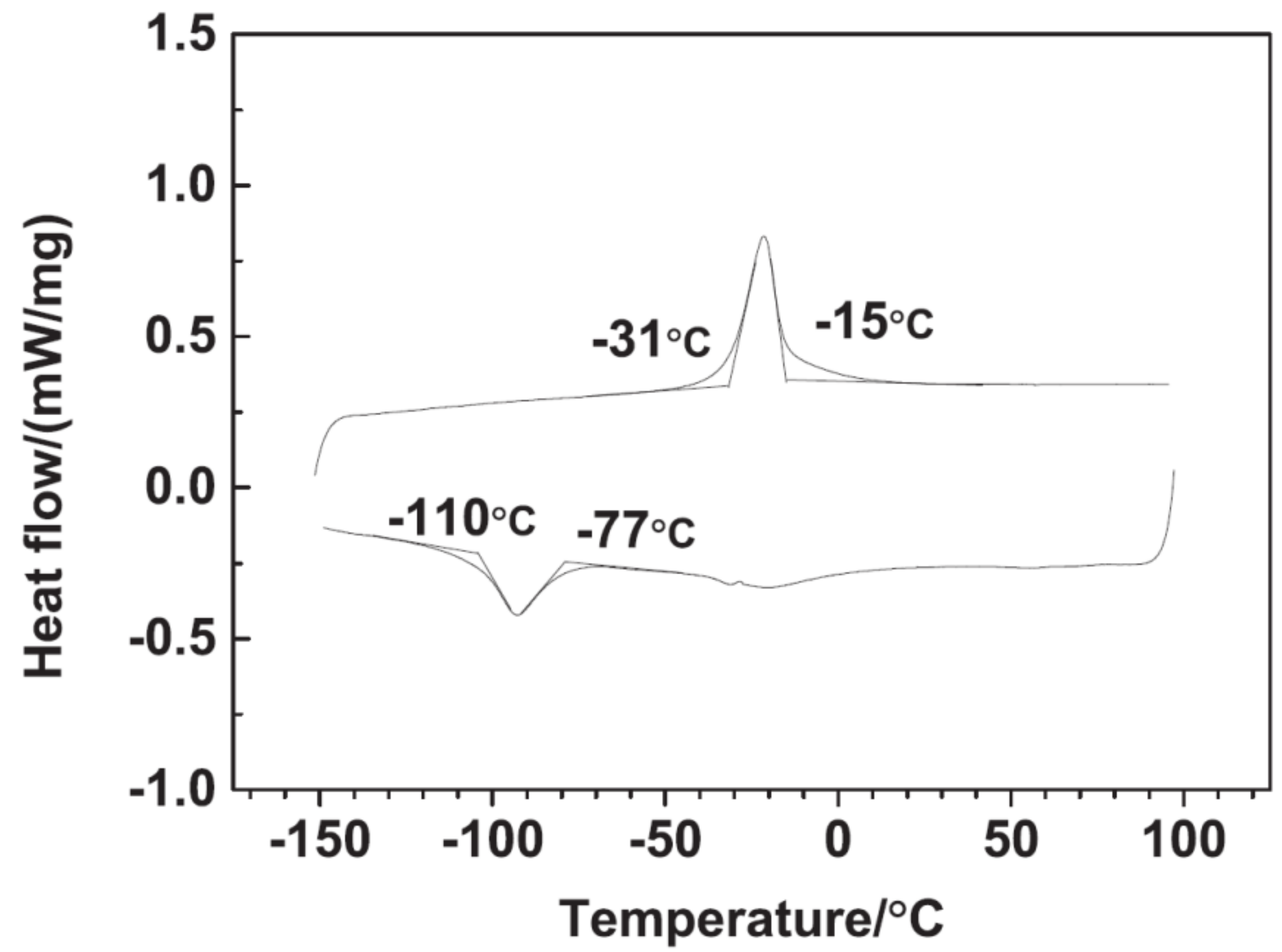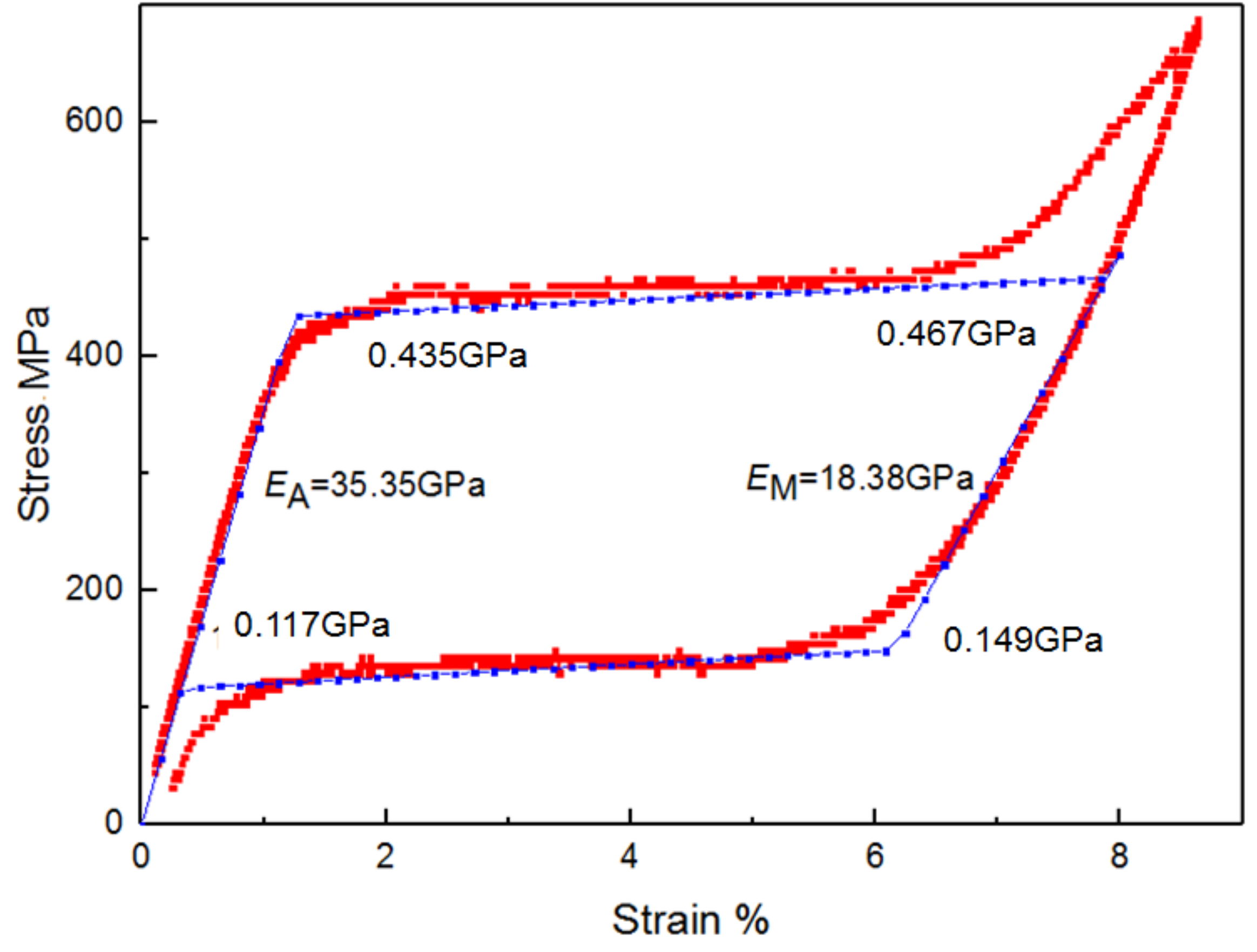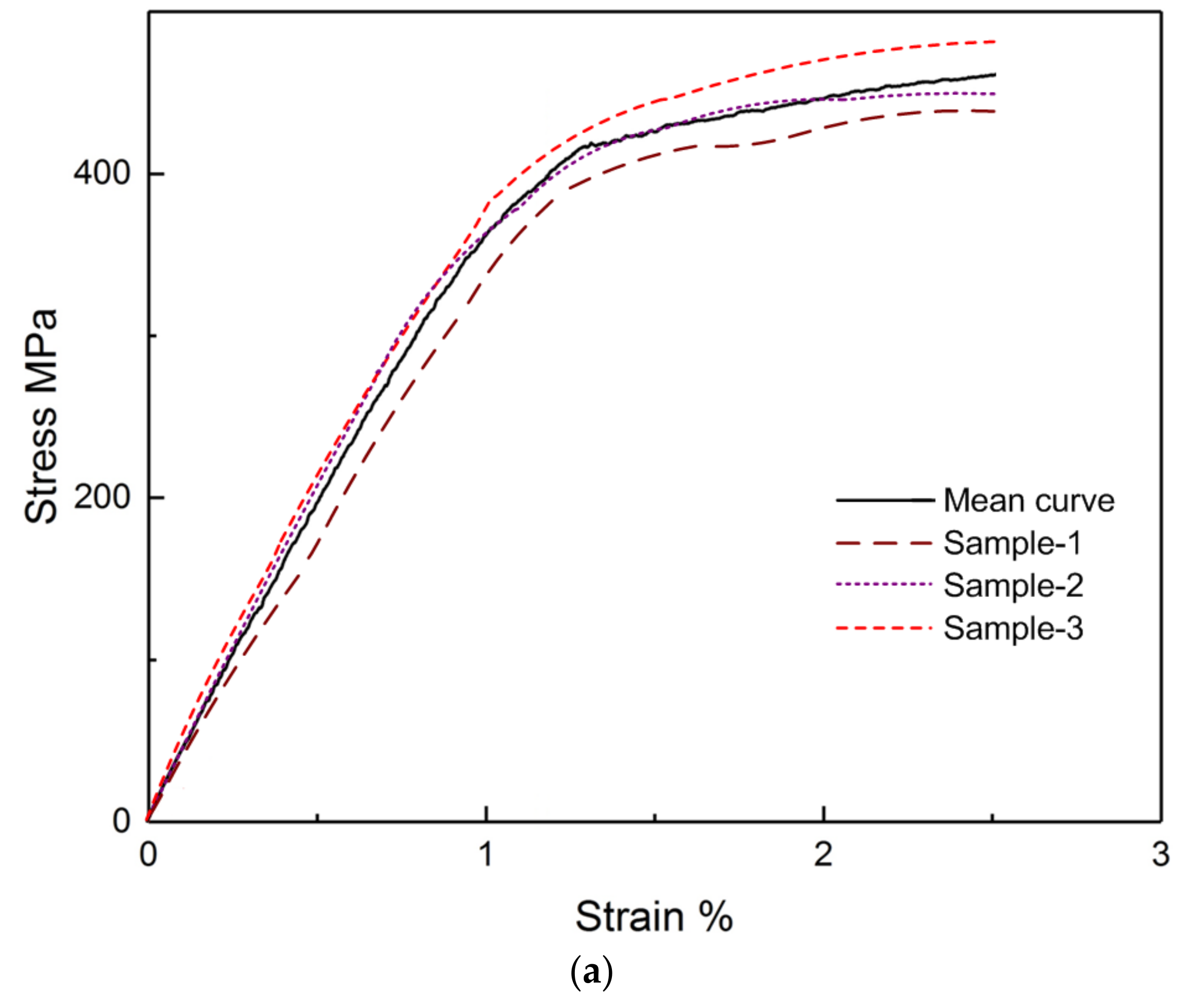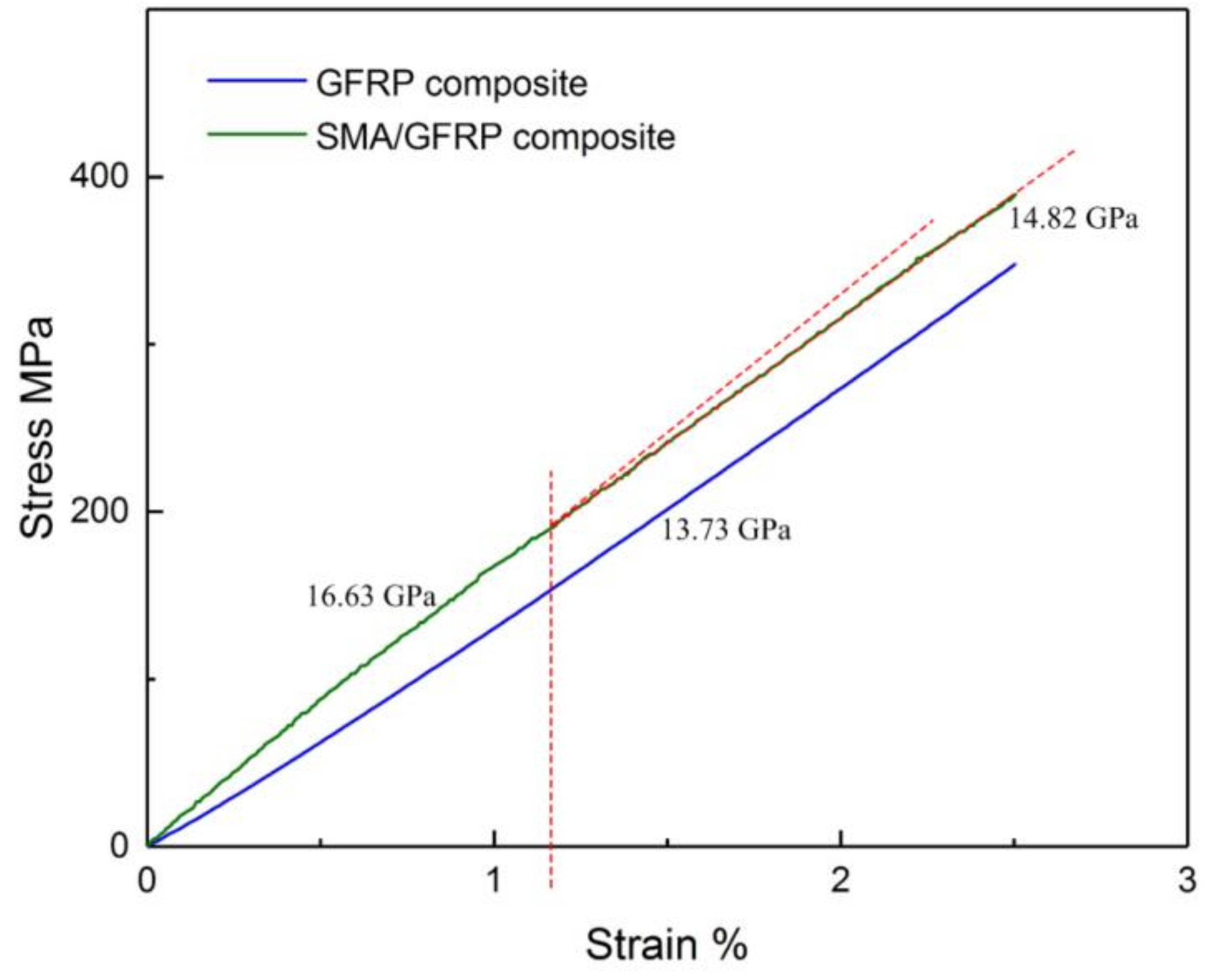Experimentation of the Bilinear Elastic Behavior of Plain-Woven GFRP Composite with Embedded SMA Wires
Abstract
:1. Introduction
2. Materials and Work Method
2.1. Materials
2.2. Manufacturing
- (1)
- A release cloth is evenly coated on the surface of the glass plate. One layer of glass fabric is placed on the release cloth, and the SMA wires are placed on top of the glass fabric layer. This process is repeated until all the glass fabrics and SMA wires are stacked according to the schematic diagram shown in Figure 3. A picture of a portion of a glass fabric layer with the SMA wires on top is shown in Figure 4.
- (2)
- The stacked fabrics with embedded SMA wires are covered with the release cloth and infusion net, which is then closed by a vacuum bag and a sealant tape. To draw a vacuum inside the enclosed space and ensure the uniform flow of resin, two delivery pipes are fixed on both sides of the device. These two pipes are respectively connected to the vacuum pump and the resin infusion port.
- (3)
- The resin is mixed with the hardening agent and accelerating agent with a mass ratio of 100:1.5:0.15. After ensuring that the device does not leak, the resin mixture is infused into the vacuum device through the infusion port. The whole system is cured at room temperature for 24 h at a vacuum level of 600 mbar.
2.3. Tensile Test
3. Results and Discussion
4. Conclusion and Perspectives
Author Contributions
Funding
Conflicts of Interest
References
- Tsoi, K.A.; Schrooten, J.; Zheng, Y.; Stalmans, R. Part II. Thermomechanical characteristics of shape memory alloy composites. Mater. Sci. Eng. 2004, 368, 299–310. [Google Scholar] [CrossRef]
- Parthenios, J.; Psarras, G.; Galiotis, C. Adaptive composites incorporating shape memory alloy wires. Part 2: development of internal recovery stresses as a function of activation temperature. Compos. Part A: Appl. Sci. Manuf. 2001, 32, 1735–1747. [Google Scholar] [CrossRef]
- Bollas, D.; Pappas, P.; Parthenios, J.; Galiotis, C. Stress generation by shape memory alloy wires embedded in polymer composites. Acta Materialia 2007, 55, 5489–5499. [Google Scholar] [CrossRef]
- Michaud, V. Can shape memory alloy composites be smart? Scr. Mater. 2004, 50, 249–253. [Google Scholar] [CrossRef]
- Balta, J.A.; Michaud, V.J.; Parlinska, M.; Gotthard, R.; Manson, J.A.E. Adaptive composite materials processing. In Proceedings of the European conference on macromolecular physics, structure development upon polymer processing: physical aspects, Guimaraes, Portugal, 24–28 September 2000. [Google Scholar]
- De Araújo, C.J.; A Rodrigues, L.F.; Neto, J.F.C.; Reis, R.P.B. Fabrication and static characterization of carbon-fiber-reinforced polymers with embedded NiTi shape memory wire actuators. Smart Mater. Struct. 2008, 17, 65004. [Google Scholar] [CrossRef]
- Lei, H.; Wang, Z.; Tong, L.; Zhou, B.; Fu, J. Experimental and numerical investigation on the macroscopic mechanical behavior of shape memory alloy hybrid composite with weak interface. Compos. Struct. 2013, 101, 301–312. [Google Scholar] [CrossRef]
- Taheri-Behrooz, F.; Taheri, F.; Hosseinzadeh, R. Characterization of a shape memory alloy hybrid composite plate subject to static loading. Mater. Des. 2011, 32, 2923–2933. [Google Scholar] [CrossRef]
- Choi, S.; Lee, J.J.; Seo, D.C.; Choi, S.W. The active buckling control of laminated composite beams with embedded shape memory alloy wires. Compos. Struct. 1999, 47, 679–686. [Google Scholar] [CrossRef]
- Angioni, S.L.; Meo, M.; Foreman, A. Impact damage resistance and damage suppression properties of shape memory alloys in hybrid composites—A review. Smart Mater. Struct. 2010, 20, 13001. [Google Scholar] [CrossRef]
- Paine, J.S.; Rogers, C.A. The response of SMA hybrid composite materials to low velocity impact. J. Intell. Mater. Syst. Struct. 1994, 5, 530–535. [Google Scholar] [CrossRef]
- Aurrekoetxea, J.; Zurbitu, J.; De Mendibil, I.O.; Agirregomezkorta, A.; Sanchez-Soto, M.; Sarrionandia, M. Effect of superelastic shape memory alloy wires on the impact behavior of carbon fiber reinforced in situ polymerized poly(butylene terephthalate) composites. Mater. Lett. 2011, 65, 863–865. [Google Scholar] [CrossRef]
- Meo, M.; Marulo, F.; Guida, M.; Russo, S. Shape memory alloy hybrid composites for improved impact properties for aeronautical applications. Compos. Struct. 2013, 95, 756–766. [Google Scholar] [CrossRef]
- Lei, H.; Wang, Z.; Zhou, B.; Tong, L.; Wang, X. Simulation and analysis of shape memory alloy fiber reinforced composite based on cohesive zone model. Mater. Des. 2012, 40, 138–147. [Google Scholar] [CrossRef]
- ASTM D3039/D3039M-08. Standard Test Method for Tensile Properties of Polymer Matrix Composite Materials; ASTM International: West Conshohocken, PA, USA, 2008. [Google Scholar]









| Constituent | Young’s Modulus (GPa) | Poison Ratio |
|---|---|---|
| Glass fiber | 70.0 | 0.22 |
| Epoxy resin | 2.0 | 0.4 |
| Samples | Glass Fiber (%) | SMA (%) | Resin (%) |
|---|---|---|---|
| GFRP sample | 73.26 | 0 | 26.74 |
| SMA/GFRP sample | 68.35 | 7.92 | 23.73 |
© 2019 by the authors. Licensee MDPI, Basel, Switzerland. This article is an open access article distributed under the terms and conditions of the Creative Commons Attribution (CC BY) license (http://creativecommons.org/licenses/by/4.0/).
Share and Cite
Sun, Z.; Xu, Y.; Wang, W. Experimentation of the Bilinear Elastic Behavior of Plain-Woven GFRP Composite with Embedded SMA Wires. Polymers 2019, 11, 405. https://doi.org/10.3390/polym11030405
Sun Z, Xu Y, Wang W. Experimentation of the Bilinear Elastic Behavior of Plain-Woven GFRP Composite with Embedded SMA Wires. Polymers. 2019; 11(3):405. https://doi.org/10.3390/polym11030405
Chicago/Turabian StyleSun, Zhiwei, Yingjie Xu, and Wenzhi Wang. 2019. "Experimentation of the Bilinear Elastic Behavior of Plain-Woven GFRP Composite with Embedded SMA Wires" Polymers 11, no. 3: 405. https://doi.org/10.3390/polym11030405
APA StyleSun, Z., Xu, Y., & Wang, W. (2019). Experimentation of the Bilinear Elastic Behavior of Plain-Woven GFRP Composite with Embedded SMA Wires. Polymers, 11(3), 405. https://doi.org/10.3390/polym11030405





